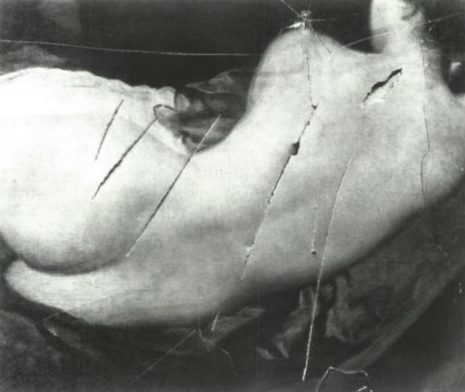
When I was in high school I was fortunate enough to go on a trip with EF Tours to Europe. While a good number of my classmates were focused on a lower drinking age, I was hyped to see some of the world’s great museums, especially the Louvre. Once we got there, I made b-line to the sculpture area. As I perused the many historic and impressive works of art, I saw something that made my brain pause for a moment. Standing in between the legs of one of the large Foo-Dog Statues was a smiling Korean man my dad’s age. He had stepped over the rope and was happily posing, with his hands above his head touching the statue’s mouth, as his wife and daughter casually snapped a picture. The French security guards had him wrangled and back on the right side of the rope in seconds without too much fuss, but I’ll never forget how jarred I was just seeing someone touch an irreplaceable work of art. Below are eight instances where someone did a whole lot more than touch. I hope you enjoy.
1. Lazlo Toth vs. Michelangelo’s La Pieta
 One of the most famous pieces of art in Rome, Michelangelo’s La Pieta sits in St. Peter’s Basilica. The marble depiction of Mary cradling Jesus’ body in her arms was originally commissioned for the funerary monument of a French Cardinal and took two years to complete. It spent a short time in its intended location before eventually being relocated to the St. Peter’s. The statue had a number of high-profile incidents during its time in Rome, but the attack by Lazlo Toth was both the worst and the most famous. Toth, a geologist from Australia who moved to Italy in 1971 to declare himself Jesus Christ and develop his following. On May 21, 1972, Toth made his way into the Basilica with his trusty geologist’s rock hammer and managed to get close enough to the statue to strike it fifteen times, the whole while shouting that he was the son of God, back from the dead and apparently peeved about his marble likeness. He was able to remove the right forearm, part of the nose and one of the eyelids before he could be stopped. In the end Toth was subdued not by security, but, rather aggressively, by surrounding tourists and bystanders. Toth, clearly unstable, was institutionalized before being deported. He died in a care facility in 2012. As for La Pieta, many of the pieces struck off by Toth were grabbed and kept by the onlookers not busy giving Toth a beat down. Some returned their shards but most didn’t. Probably the most famous, and technically stolen, piece is her nose which had to be reformed from a chunk of marble taken from her back. Very modern indeed.
One of the most famous pieces of art in Rome, Michelangelo’s La Pieta sits in St. Peter’s Basilica. The marble depiction of Mary cradling Jesus’ body in her arms was originally commissioned for the funerary monument of a French Cardinal and took two years to complete. It spent a short time in its intended location before eventually being relocated to the St. Peter’s. The statue had a number of high-profile incidents during its time in Rome, but the attack by Lazlo Toth was both the worst and the most famous. Toth, a geologist from Australia who moved to Italy in 1971 to declare himself Jesus Christ and develop his following. On May 21, 1972, Toth made his way into the Basilica with his trusty geologist’s rock hammer and managed to get close enough to the statue to strike it fifteen times, the whole while shouting that he was the son of God, back from the dead and apparently peeved about his marble likeness. He was able to remove the right forearm, part of the nose and one of the eyelids before he could be stopped. In the end Toth was subdued not by security, but, rather aggressively, by surrounding tourists and bystanders. Toth, clearly unstable, was institutionalized before being deported. He died in a care facility in 2012. As for La Pieta, many of the pieces struck off by Toth were grabbed and kept by the onlookers not busy giving Toth a beat down. Some returned their shards but most didn’t. Probably the most famous, and technically stolen, piece is her nose which had to be reformed from a chunk of marble taken from her back. Very modern indeed.
2. The Situationists vs. Edvard Eriksen’s The Little Mermaid

The Little Mermaid comes up regularly on lists of fairy tales that are far darker than the Disney adaptation would lead you to believe and this story stays in that mold. The statue of the story’s titular character was completed in Copenhagen in 1909 and has had a fairly rough go of it since. Paint, burqas, dildos (don’t hear those two in a row often) and political statements have all been put on the statue for one reason or another, but in 1964 the statue suffered its worst desecration yet. A group of avant-garde Marxists (only in Europe) known as the Situationists decided that to protest consumer society they would decapitate the statue. While the ring leader of the group has been identified as Jorgen Nash, the head itself has never been located. A new head had to be made for the statue but that too was stolen in 1998, though this time it was anonymously returned. There have been two new acts committed so far in 2017 and, if history serves as any indication, there will be plenty more so long as they keep the poor girl out there. Apparently someone agrees with me because there are potential plans to move the statue farther out into the water to deter future vandals.
Or challenge the great ones. Only time will tell.
3. Alexander Brener vs. Kazimir Malevich’s Suprematisme
Kazmir Malevich was not just an avant-garde painter, he was an art theoretician. He developed his own style called Suprematism that focused on severe depictions of geometric abstractions (ask your art friends what that means, because how a square can be severe is beyond me). His work was suppressed by the Soviets as their brand of Socialist Realism (riveting I’m sure) became the preferred style of the new order. Once the commies settled down a bit Malevich came back into style and his works began to rise in popularity around the globe. Enter Alexander Brener, a different kind of artist. While Malevich focused on capturing the mystical aspects of Christianity via his severe shapes, Brener did performance art like shitting in front of a Van Gough one time and engaging in public street sex. In other words, they were two peas in a pod. In 1997, over six decades after Malevich’s death, Brener was arrested for painting a green dollar sign on his painting Suprematisme. Sentenced to five months in prison, Brener rejected the idea that he had ‘vandalized’ anything. In his words, all he had done was engage in “a dialogue with Malevich”, despite the fact that the other man had died in the thirties. Exactly the kind of response you’d expect from a hack who thinks where you shit determines whether or not it is art.
4. Hans-Joachim Bohlmann vs. Works of Albrecht Dürer
Albrecht Dürer was a Renaissance era artist from Germany who was renowned for his wood-cuts and is considered by some to be one of Europe’s first landscape artists. His work, like many of his more famous contemporaries, was mostly religious in nature, but Dürer seemed particularly interested in scenes of the apocalypse. Many contribute this to the fact that his lifetime coincided with the birth of the Reformation and the many hardships and horrors that era saw. After his death, Dürer remained popular in the art world and especially in Germany. Fast-forward to March of 1988 and serial art vandal Hans-Joachim Bohlman, shortly after being released from treatment for a previous vandalism related crime, is in Munich, hiding two liters of sulfuric acid in a public park. A month later, he scoops his stash of illegally obtained acid (he’d used the stuff before numerous times, and had been forbidden from buying it) and headed to Munich’s Alte Pinakothek Art Museum. There he picked out three paintings by Germany’s most beloved Renaissance figure and threw his two liters all over the three of them causing 35,000,000 euros worth of damage. Why did he do this you ask? He was angry about having to pay for his last act of vandalism. Shortly after the deed was done, Bohlman was captured and kept under psychiatric evaluation. He escaped from psychiatric care multiple times before eventually being released in 2006. To celebrate his new freedom, he took a little vacation to the Rijksmuseum in Amsterdam. There he eschewed his acid and decided to douse lighter fluid on Bartholomeus van der Helst’s Banquet of the Amsterdam Civic Guard in Celebration of the Peace of Münster and let it burn. Luckily the painting had a thick enough layer of varnish on it that damage was minimal. This final act earned Bohlman another three years. He died of cancer in 2009. The works of Dürer’s that he attacked may be irreparably damaged. Experts say restoration can help to a degree, but that the marks of Bohlman’s attack may never be fully erased.
5. The Catholic Church vs. Vasily Vereshchagin’s Religious Works

Vasily Vereshchagin was a Russian war artist, which is only about half as cool as it sounds. War artists served a similar function to war photographers today; they depicted the horrors and realities of war for those unable to witness it first hand. Vasily was by all regards so good at this job that many of his works were deemed too graphic for 19th century Russian eyes, which means they had to be pretty damn graphic. His realism both made him famous and earned him the ire of the Catholic Church. In an era where religious art was ornate, symbolic and fanciful, Vereshchagin began to create works that captured what was, in his view, the true nature of biblical times and events. His paintings The Holy Family and The Resurrection of Christ were two such works and despite the fact that the Church had condemned them, he displayed them at an exhibition in Vienna in 1880. While on display there, either a Catholic monk or a religious zealot, accounts seem to differ, doused both of the paintings in acid. Neither was ultimately salvageable. Vasily was undeterred by this and kept painting, though his realism became less graphic as he grew older. He died when his ship struck a mine during the Russo-Japanese war.
6. Mary Richardson vs. Diego Velazquez’ Rokeby Venus

Diego Velazquez was a titan of the baroque style in the Golden Age of Spain. He has created many classic masterpieces and served in the court of King Philip IV, providing the king and his family with many flattering portraits. One of his most famous works, and his only surviving nude, is the Rokeby Venus. The painting depicts Venus, lounging naked on a bed or couch of some kind, gazing into her own reflection in a mirror held by Cupid. The fact that this painting survived the Spanish Inquisition is impressive, but what the inquisitors could not accomplish, feminists took a crack at. Mary Richardson, a Canadian born suffragette and future British Fascist, was in London in 1914 and had just witnessed the arrest of her fellow suffragette Emmeline Pankhurst. To protest what she described as the ‘destroying [of] Mrs. Pankhurst, who is the most beautiful character in modern history’, she walked into the National Gallery in London with a meat cleaver and let Venus have it. While the damage her seven cleaver slashes left on the painting looked awful, all were eventually able to be repaired. She was released six months after her arrest for the act and did not comment on it again until 1952, when she said that she hadn’t liked the men ogling the portrait all day to begin with. She lived a mostly quiet life after that, becoming disillusioned with the Fascists in the 1930’s (good call Mary) and dying in England in 1961. The Rokeby Venus is still on display at the National Gallery in London.
Art 1, British Fascists 0 (seriously look into the BUF, not a successful little movement).
7. Robert Cambridge vs. DaVinci’s The Virgin and Child with St. Anne and St. John the Baptist

Acid, knives and paint are the staple tools for your average art vandal. They are easily obtained, not necessarily illegal to own and not difficult to conceal as you skulk through Art Museums looking for prey, which is what makes the assault on DaVinci’s The Virgin and Child with St. Anne and St. John the Baptist so unusual. The work itself is a chalk and charcoal drawing many believe was simply a reference for a painting either lost or never completed. It shows Mary and Anne holding baby Jesus while a young John the Baptist lingers near the infant’s face. The drawing has been housed in the National Gallery in London for a while now and has had a fair degree of popularity during its residency there. This must have made it all the more traumatic when Robert Cambridge, a man determined to express his anger at the current status quo, showed up at the museum with not acid, not paint, but a sawed-off shotgun. How he got it in the museum and why it was his weapon of choice are still unknowns, but he did blast the painting from about seven feet away. The protective glass did its job for the most part, but the force of the blast shattered it and the shards of glass and splinters of wood caused serious damage to the art within. He was hospitalized after the event and the drawing, though it took over a year, was restored. All things considered, it is pretty lucky Mr. Cambridge was only after the art.
8. Jubal Brown vs. ‘Boring Art’

Vandalism is bad. I hope nothing I wrote here suggests otherwise, but this next entry is actually kind of funny even if its still horrible. Much like our defecating ‘artist’ in the Malevich entry, Jubal Brown considered himself to be somewhat of a performance artist and provocateur. On May 15th, 1996, Brown waltzed into the Art Gallery of Ontario after gorging himself on red gelatin and red icing and vomited red stuff all over Raoul Dufy’s Harbor at le Havre. The museum assumed it was an accident and had the painting cleaned without issue or pursuit of legal action against Brown. Then, on November 2nd of that same year, this time full to the brim of blue stuff (icing and jello once again), he vomited on Composition with Red and Blue by Piet Mondrian. Somehow, they gave him the benefit of the doubt a second time, but by December he had confessed that it was all part of a ‘performance art trilogy’ in which he had planned to vomit on art he thought boring or trite in all three of the primary colors. While he wasn’t jailed for these crimes, he was robbed of the opportunity to vomit yellow on anything at all. Well at least not anything in public. God only knows what a man who intentionally vomits on public art does in private.
Thanks for reading. For other lists on various subjects check out our Archives



8 thoughts on “8 Insane Instances of Art Vandalism”